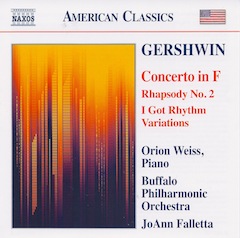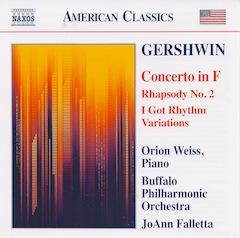
Having put himself on the map with Rhapsody in Blue (1924), the 26-year old George Gershwin set out to prove that he was anything but a one-note wonder. Over the next decade, he produced three other major works for piano and orchestra: Concerto in F (1925), Rhapsody No. 2 (aka “Second Rhapsody”) (1931), and I Got Rhythm Variations (1934).
On this new Naxos CD, all but the grossly over-recorded Rhapsody in Blue receive bang-up, knock down treatment in the hands of 30-year old Orion Weiss. The Classical Recording Foundation’s 2010 Young Artist of the Year, who puts his all into the music, receives rousing support from Music Director JoAnn Falletta and her Buffalo Philharmonic Orchestra.
For those who don’t know the works, they are unmistakably “Gershwin” from first note to last. Concerto in F, for example, may have been written in response to a commission from the New York Symphony under Walter Damrosch to compose a “proper concerto,” yet what Gershwin himself considered proper would never have flown from the pen of his European contemporaries, let alone the Second Viennese School of Berg, Webern, and Schoenberg.
In a somewhat dry recording that favors midrange fullness and bass “slam” over treble brilliance, and that gives the piano undue prominence, Weiss sounds more weighty than insouciant as he plays up a storm. The Concerto in F gives him relatively few measures to display sensitivity and shading, though he makes the most of them. Then he begins to fly all over the keyboard, often banging away as though the construction of the Empire State Building is at stake. The performance is one of the longest ever on CD, with only the slower, evocative second movement faster than two of the five other versions I have on hand.
Seriously “Riveting” Score
The Rhapsody No. 2, initially titled Rhapsody in Rivets, then New York Rhapsody, grew out of Gershwin’s engagement by Fox Studios to compose a six-minute interlude for its forthcoming film Delicious. Because the movie sequence briefly showed rivets tossed about, then hammered into steel girders, Gershwin gave to the piano’s opening bars the unmistakable sound of you-know-what. One way or another, the riveting never stops. With orchestration far more sophisticated than in the Concerto, the performance is irresistible.
Gershwin seems to be laughing all the way.
Basing it on the hit melody from his 1930 musical Girl Crazy, Gershwin composed his I Got Rhythm Variations for Piano and Orchestra for a four-week concert tour that he undertook with Damrosch’s New York Symphony. The piano has but a few bars to ruminate before, bang!, the orchestra starts, paving the way for the piano’s initial dance through the melody. Then matters get far more complex, with variations that jump from jazz to a tongue-in-cheek, rather inebriated waltz, then to Gershwin’s imitation of out-of-tune Chinese flutes. Gershwin seems to be laughing all the way.
At the keyboard, Weiss seems less interested in subtlety and swing than driving in the fast lane. Nonetheless, unless you desire a more authentic approach with greater glint in the eye, or favor different instrumental and sonic balances, you'll likely be so enamored of Weiss' driving that you jump into the passenger's seat without regard for the road signs that he whizzes past. Especially when Naxos' toll makes the ride more affordable than some.


